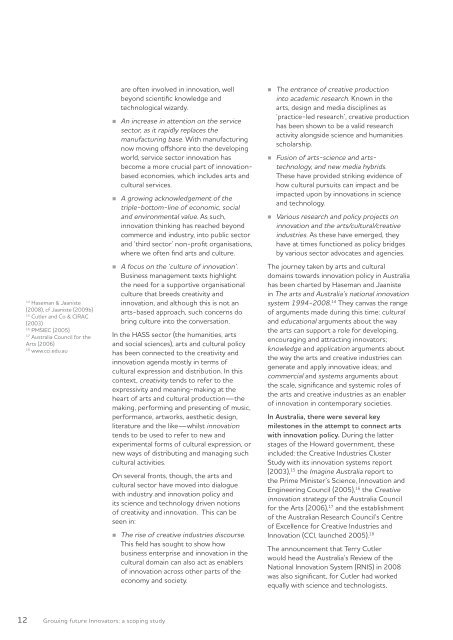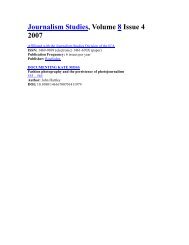GrowinG Future innovators - ARC Centre of Excellence for Creative ...
GrowinG Future innovators - ARC Centre of Excellence for Creative ...
GrowinG Future innovators - ARC Centre of Excellence for Creative ...
Create successful ePaper yourself
Turn your PDF publications into a flip-book with our unique Google optimized e-Paper software.
12<br />
14 Haseman & Jaaniste<br />
(2008), cf Jaaniste (2009b)<br />
15 Cutler and Co & CIRAC<br />
(2003)<br />
16 PMSIEC (2005)<br />
17 Australia Council <strong>for</strong> the<br />
Arts (2006)<br />
18 www.cci.edu.au<br />
Growing future Innovators: a scoping study<br />
are <strong>of</strong>ten involved in innovation, well<br />
beyond scientific knowledge and<br />
technological wizardy.<br />
An increase in attention on the service<br />
sector, as it rapidly replaces the<br />
manufacturing base. With manufacturing<br />
now moving <strong>of</strong>fshore into the developing<br />
world, service sector innovation has<br />
become a more crucial part <strong>of</strong> innovationbased<br />
economies, which includes arts and<br />
cultural services.<br />
A growing acknowledgement <strong>of</strong> the<br />
triple-bottom-line <strong>of</strong> economic, social<br />
and environmental value. As such,<br />
innovation thinking has reached beyond<br />
commerce and industry, into public sector<br />
and ‘third sector’ non-pr<strong>of</strong>it organisations,<br />
where we <strong>of</strong>ten find arts and culture.<br />
A focus on the ‘culture <strong>of</strong> innovation’.<br />
Business management texts highlight<br />
the need <strong>for</strong> a supportive organisational<br />
culture that breeds creativity and<br />
innovation, and although this is not an<br />
arts-based approach, such concerns do<br />
bring culture into the conversation.<br />
In the HASS sector (the humanities, arts<br />
and social sciences), arts and cultural policy<br />
has been connected to the creativity and<br />
innovation agenda mostly in terms <strong>of</strong><br />
cultural expression and distribution. In this<br />
context, creativity tends to refer to the<br />
expressivity and meaning-making at the<br />
heart <strong>of</strong> arts and cultural production—the<br />
making, per<strong>for</strong>ming and presenting <strong>of</strong> music,<br />
per<strong>for</strong>mance, artworks, aesthetic design,<br />
literature and the like—whilst innovation<br />
tends to be used to refer to new and<br />
experimental <strong>for</strong>ms <strong>of</strong> cultural expression, or<br />
new ways <strong>of</strong> distributing and managing such<br />
cultural activities.<br />
On several fronts, though, the arts and<br />
cultural sector have moved into dialogue<br />
with industry and innovation policy and<br />
its science and technology driven notions<br />
<strong>of</strong> creativity and innovation. This can be<br />
seen in:<br />
The rise <strong>of</strong> creative industries discourse.<br />
This field has sought to show how<br />
business enterprise and innovation in the<br />
cultural domain can also act as enablers<br />
<strong>of</strong> innovation across other parts <strong>of</strong> the<br />
economy and society.<br />
The entrance <strong>of</strong> creative production<br />
into academic research. Known in the<br />
arts, design and media disciplines as<br />
‘practice-led research’, creative production<br />
has been shown to be a valid research<br />
activity alongside science and humanities<br />
scholarship.<br />
Fusion <strong>of</strong> arts-science and artstechnology,<br />
and new media hybrids.<br />
These have provided striking evidence <strong>of</strong><br />
how cultural pursuits can impact and be<br />
impacted upon by innovations in science<br />
and technology.<br />
Various research and policy projects on<br />
innovation and the arts/cultural/creative<br />
industries. As these have emerged, they<br />
have at times functioned as policy bridges<br />
by various sector advocates and agencies.<br />
The journey taken by arts and cultural<br />
domains towards innovation policy in Australia<br />
has been charted by Haseman and Jaaniste<br />
in The arts and Australia’s national innovation<br />
system 1994-2008. 14 They canvas the range<br />
<strong>of</strong> arguments made during this time: cultural<br />
and educational arguments about the way<br />
the arts can support a role <strong>for</strong> developing,<br />
encouraging and attracting <strong>innovators</strong>;<br />
knowledge and application arguments about<br />
the way the arts and creative industries can<br />
generate and apply innovative ideas; and<br />
commercial and systems arguments about<br />
the scale, significance and systemic roles <strong>of</strong><br />
the arts and creative industries as an enabler<br />
<strong>of</strong> innovation in contemporary societies.<br />
In Australia, there were several key<br />
milestones in the attempt to connect arts<br />
with innovation policy. During the latter<br />
stages <strong>of</strong> the Howard government, these<br />
included: the <strong>Creative</strong> Industries Cluster<br />
Study with its innovation systems report<br />
(2003), 15 the Imagine Australia report to<br />
the Prime Minister’s Science, Innovation and<br />
Engineering Council (2005), 16 the <strong>Creative</strong><br />
innovation strategy <strong>of</strong> the Australia Council<br />
<strong>for</strong> the Arts (2006), 17 and the establishment<br />
<strong>of</strong> the Australian Research Council’s <strong>Centre</strong><br />
<strong>of</strong> <strong>Excellence</strong> <strong>for</strong> <strong>Creative</strong> Industries and<br />
Innovation (CCI, launched 2005). 18<br />
The announcement that Terry Cutler<br />
would head the Australia’s Review <strong>of</strong> the<br />
National Innovation System (RNIS) in 2008<br />
was also significant, <strong>for</strong> Cutler had worked<br />
equally with science and technologists,




![Plebiscite (Riegert chapter) revised FINAL [Feb 14].pdf](https://img.yumpu.com/8710373/1/190x245/plebiscite-riegert-chapter-revised-final-feb-14pdf.jpg?quality=85)